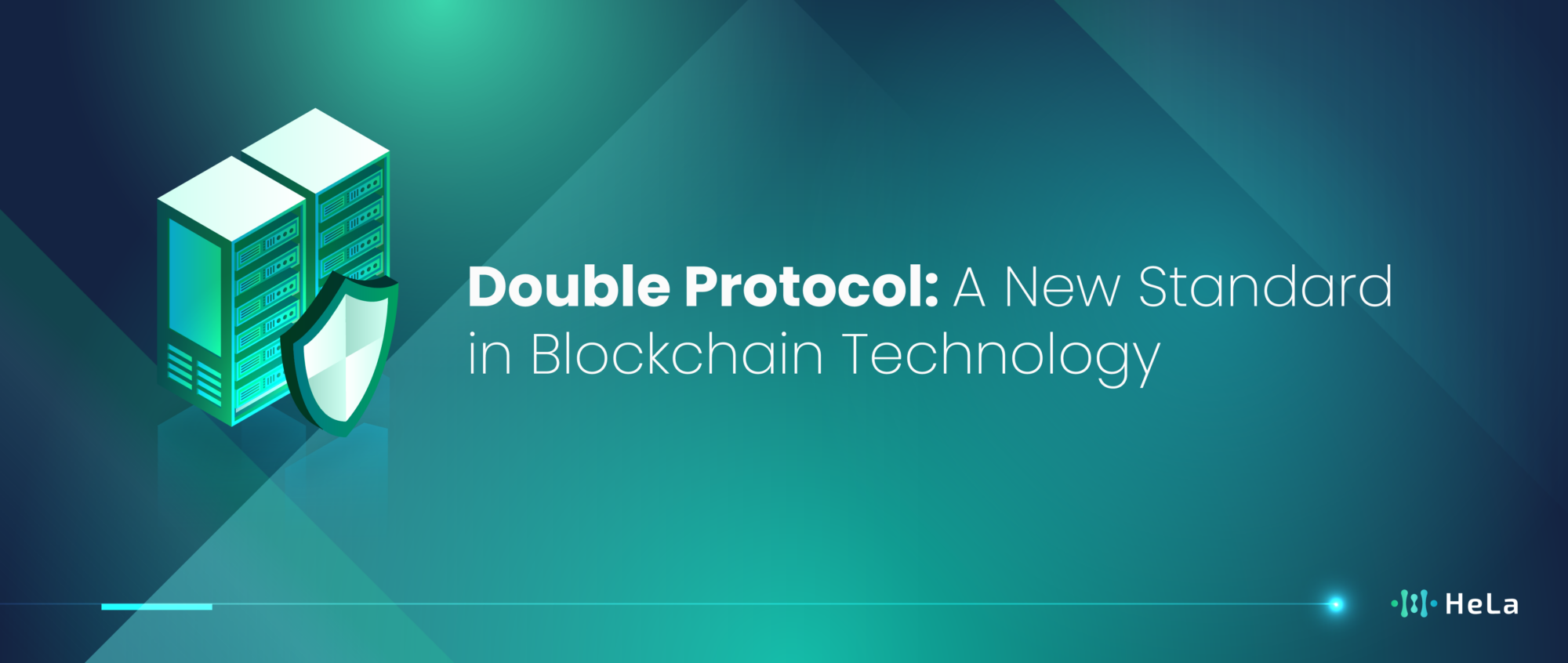Blockchain technology has significantly evolved over the past decade, offering new ways to handle data, transactions, and security. One of the most recent advancements in this field is the Double Protocol. This new standard aims to address some of the fundamental challenges faced by current blockchain systems, such as scalability and security.
Double Protocol introduces a dual-layer approach that enhances both the efficiency and the robustness of blockchain networks. By incorporating this new protocol, blockchain developers and users can experience faster transaction times and improved data integrity. The potential applications of Double Protocol span across various industries, including finance, healthcare, and supply chain management.
In this article, we will delve into the specifics of Double Protocol, exploring its key features, benefits, and potential impact on the blockchain landscape. We will also discuss how this protocol stands out from existing technologies and why it could be the next big thing in blockchain innovation.
What is Double Protocol?

Double Protocol is a blockchain framework designed to improve the performance and security of blockchain networks. Unlike traditional single-layer protocols, Double Protocol operates on a dual-layer system, which separates the transactional and consensus processes. This separation allows for more efficient transaction handling and reduces the risk of network congestion.
The first layer of Double Protocol is responsible for transaction processing. It ensures that all transactions are validated quickly and efficiently. The second layer focuses on consensus, where it verifies the transactions and ensures the integrity of the blockchain. By dividing these responsibilities, Double Protocol enhances the overall throughput and reliability of the network.
Moreover, Double Protocol incorporates advanced cryptographic techniques to further secure transactions and data. This ensures that the information on the blockchain remains tamper-proof and transparent, providing a higher level of trust and reliability compared to older blockchain systems.
Benefits of Double Protocol

Double Protocol offers several benefits that make it a compelling choice for blockchain networks. One of the primary advantages is its ability to handle a larger number of transactions per second (TPS) compared to traditional protocols. This scalability is crucial for applications that require high-speed transactions, such as financial services and online marketplaces.
Another significant benefit is the enhanced security provided by the dual-layer system. By separating transaction processing and consensus, Double Protocol minimizes the risk of attacks and fraud. The use of advanced cryptographic methods further strengthens the security, making it harder for malicious actors to compromise the network.
Additionally, Double Protocol supports interoperability with other blockchain networks. This means that it can be integrated with existing systems without requiring major overhauls, facilitating smoother transitions and broader adoption. The flexibility and adaptability of Double Protocol make it suitable for a wide range of applications, from supply chain tracking to digital identity verification.
Scalability
One of the standout features of Double Protocol is its remarkable scalability. Traditional blockchain protocols often struggle with limited transaction throughput, leading to delays and higher transaction costs. Double Protocol addresses this issue by optimizing its dual-layer architecture to handle a significantly higher number of transactions per second. This capability is particularly beneficial for industries that rely on real-time data processing and rapid transaction verification, such as finance and e-commerce. By providing a scalable solution, Double Protocol ensures that blockchain technology can keep pace with growing user demands and expanding applications.
Also Read: 10 Best Crypto Yield Farming to Know in 2024
Enhanced Security
Security is a paramount concern in the blockchain space, and Double Protocol excels in this area. The dual-layer design separates transaction processing from consensus mechanisms, reducing the attack surface and making it more challenging for malicious actors to exploit vulnerabilities. Advanced cryptographic techniques further bolster the security framework, ensuring that data remains protected and tamper-proof. This enhanced security makes Double Protocol a trustworthy choice for applications that handle sensitive information, such as healthcare records and financial transactions.
Interoperability
Interoperability is another key advantage of Double Protocol. In the current blockchain ecosystem, many networks operate in isolation, creating silos that limit the potential for cross-platform interactions. Double Protocol is designed to bridge these gaps by supporting seamless integration with other blockchain systems.
This interoperability facilitates the exchange of data and assets across different platforms, promoting greater collaboration and innovation. Whether it’s integrating with existing enterprise systems or connecting with other blockchain networks, Double Protocol’s adaptability makes it a versatile solution for a wide range of use cases.
Applications of Double Protocol

Double Protocol’s unique features open up numerous possibilities across various industries. In the financial sector, for instance, it can streamline payment processing, reduce transaction costs, and enhance the overall speed of financial transactions. This can lead to more efficient banking operations and improved customer experiences.
Financial Sector
In the financial sector, Double Protocol has the potential to revolutionize how transactions are handled. By increasing transaction speeds and reducing costs, it offers a more efficient alternative to traditional banking methods.
Financial institutions can leverage this technology to provide faster services to their customers, improve transaction security, and lower operational costs. This can also enable the development of new financial products and services that were previously not feasible due to technical limitations.
Healthcare
In healthcare, Double Protocol can be used to securely store and share patient records. The dual-layer approach ensures that sensitive information remains confidential while allowing authorized parties to access and verify data quickly.
This can improve patient care and facilitate better coordination between healthcare providers. Additionally, it can support the secure transfer of medical data between institutions, ensuring that patient information is accurate and up-to-date, which is crucial for effective treatment and care.
Supply Chain Management
Supply chain management is another area where Double Protocol can make a significant impact. By providing a transparent and tamper-proof record of goods as they move through the supply chain, it helps in tracking and verifying the authenticity of products.
This can reduce fraud, improve inventory management, and enhance the overall efficiency of supply chain operations. Companies can ensure the integrity of their products from production to delivery, which is vital for maintaining consumer trust and meeting regulatory requirements.
Digital Identity Verification
Double Protocol also holds promise in the field of digital identity verification. With growing concerns about privacy and security in online transactions, a reliable method for verifying identities is essential.
Double Protocol can offer a secure and efficient way to verify identities, ensuring that personal information is protected while enabling seamless online interactions. This can be particularly useful for services that require robust identity verification, such as online banking, e-commerce, and governmental services.
Double Protocol vs. Traditional Blockchain Protocols
While traditional blockchain protocols have their strengths, Double Protocol offers several improvements that set it apart. Traditional protocols often face challenges related to scalability and security. The single-layer approach can lead to network congestion and slower transaction times, especially as the number of users grows.
Scalability Challenges
One of the primary issues with traditional blockchain protocols is scalability. As the number of users and transactions increases, these networks often struggle to maintain efficient processing speeds. Network congestion can lead to slower transaction times and higher fees, which can be detrimental to user experience and application performance.
Double Protocol addresses these issues by implementing a dual-layer system. This separation allows for more efficient transaction processing and consensus verification, leading to faster and more secure transactions. By distributing the workload across two layers, Double Protocol can handle a significantly higher volume of transactions per second (TPS), ensuring smoother and quicker processing even during peak times.
Enhanced Security Measures
Security is another critical area where Double Protocol outshines traditional blockchain protocols. In a single-layer system, all processes, including transaction validation and consensus, occur within the same framework. This can create vulnerabilities and make the network more susceptible to attacks.
Double Protocol’s dual-layer approach enhances security by isolating transaction processing from consensus mechanisms. This separation minimizes the risk of coordinated attacks and fraud, as compromising both layers simultaneously is considerably more challenging. Additionally, the advanced cryptographic techniques used in Double Protocol offer stronger protection against cyber threats, making it a more robust solution for modern blockchain applications.
Interoperability
Another key difference is the interoperability of Double Protocol. Traditional blockchain systems often operate in silos, making it difficult to integrate with other networks. This lack of interoperability can hinder the growth and adoption of blockchain technology, as users and developers face challenges in connecting disparate systems.
Double Protocol’s design supports seamless integration with various blockchain systems, promoting greater collaboration and innovation across the industry. By enabling interoperability, Double Protocol facilitates the exchange of data and assets between different blockchain networks, opening up new possibilities for decentralized applications and services. This capability can drive broader adoption and enhance the overall utility of blockchain technology in diverse sectors.
Future Prospects of Double Protocol
The future of Double Protocol looks promising, with potential advancements and broader adoption on the horizon. As more industries recognize the benefits of this new standard, we can expect to see increased implementation across different sectors. The flexibility and scalability of Double Protocol make it an ideal candidate for addressing the evolving needs of the digital economy.
Advancements in Technology
Researchers and developers are continuously working on improving the protocol, exploring new ways to enhance its performance and security. Innovations such as quantum-resistant cryptography and AI-driven consensus mechanisms are being investigated to further strengthen the protocol’s capabilities. These advancements could make Double Protocol even more resilient and efficient in the face of emerging technological challenges.
Quantum-resistant cryptography is particularly noteworthy as it addresses potential future threats posed by quantum computing, which could potentially break traditional cryptographic methods. By incorporating quantum-resistant techniques, Double Protocol ensures long-term security and trustworthiness.
AI-driven consensus mechanisms can optimize the decision-making process within the network, improving efficiency and reducing the time required for consensus. This can lead to faster transaction times and lower energy consumption, making the protocol more sustainable and scalable.
Growing Interest in DeFi and Blockchain Applications
Moreover, the growing interest in decentralized finance (DeFi) and other blockchain-based applications will likely drive the demand for more robust and scalable protocols.
DeFi platforms require high transaction throughput and robust security to handle the complex financial operations they support. Double Protocol’s unique features position it well to meet these demands, potentially becoming a cornerstone of the future blockchain ecosystem.
As blockchain technology continues to evolve, the need for interoperable and scalable solutions will become increasingly critical. Double Protocol’s ability to integrate with various blockchain networks and its enhanced scalability make it a versatile tool for the next generation of decentralized applications.
Industry Adoption
The potential for widespread industry adoption is significant. As businesses and organizations across sectors such as finance, healthcare, supply chain, and digital identity recognize the advantages of Double Protocol, its implementation is likely to grow. The protocol’s ability to improve transaction speeds, enhance security, and support interoperability makes it an attractive choice for entities looking to leverage blockchain technology for various applications.
Also Read: 15 Best Web3 Social Networks to Consider (Update 2024)
In conclusion, the future prospects of Double Protocol are bright. With ongoing technological advancements and increasing industry adoption, it is well-positioned to become a key player in the blockchain landscape. Its innovative approach to scalability, security, and interoperability sets a new standard for blockchain protocols, paving the way for a more efficient and secure digital economy.
Conclusion
Double Protocol represents a significant leap forward in blockchain technology, offering solutions to some of the most pressing challenges faced by traditional systems. Its dual-layer approach enhances scalability and security, making it a versatile and reliable option for a wide range of applications.
As industries continue to explore and adopt blockchain technology, Double Protocol stands out as a promising new standard that can drive innovation and efficiency. By addressing key issues such as transaction speed and data integrity, it paves the way for more robust and secure blockchain networks.
The ongoing development and potential future advancements of Double Protocol indicate that it will play a crucial role in shaping the future of blockchain technology. As we move towards a more digital and decentralized world, Double Protocol is poised to become an integral part of this transformation, offering a new standard for blockchain excellence.
Disclaimer: The information provided by HeLa Labs in this article is intended for general informational purposes and does not reflect the company’s opinion. It is not intended as investment advice or recommendations. Readers are strongly advised to conduct their own thorough research and consult with a qualified financial advisor before making any financial decisions.

Joshua Soriano
I am a writer specializing in decentralized systems, digital assets, and Web3 innovation. I develop research-driven explainers, case studies, and thought leadership that connect blockchain infrastructure, smart contract design, and tokenization models to real-world outcomes.
My work focuses on translating complex technical concepts into clear, actionable narratives for builders, businesses, and investors, highlighting transparency, security, and operational efficiency. Each piece blends primary-source research, protocol documentation, and practitioner insights to surface what matters for adoption and risk reduction, helping teams make informed decisions with precise, accessible content.
- Joshua Soriano#molongui-disabled-link
- Joshua Soriano#molongui-disabled-link
- Joshua Soriano#molongui-disabled-link
- Joshua Soriano#molongui-disabled-link

